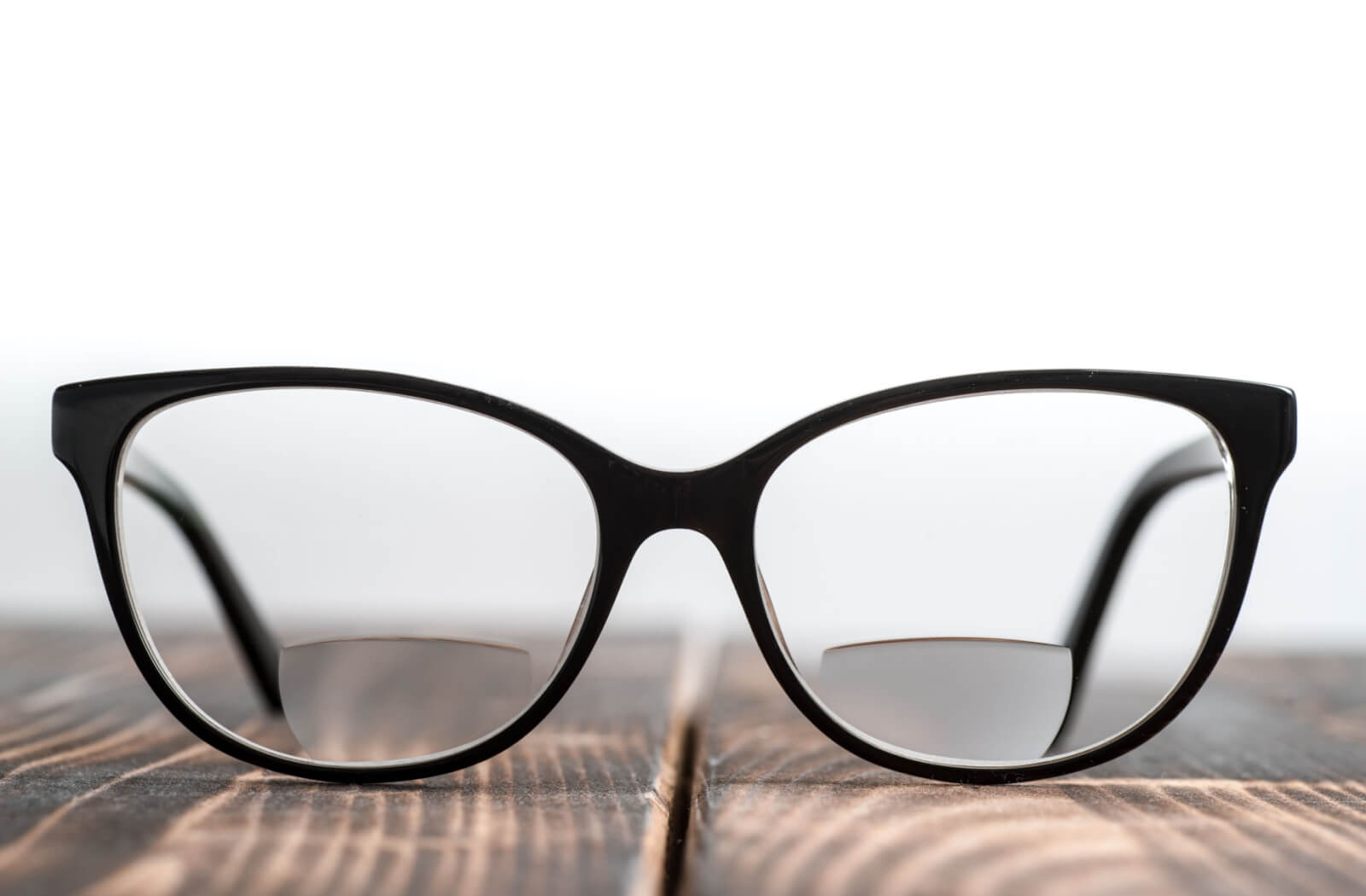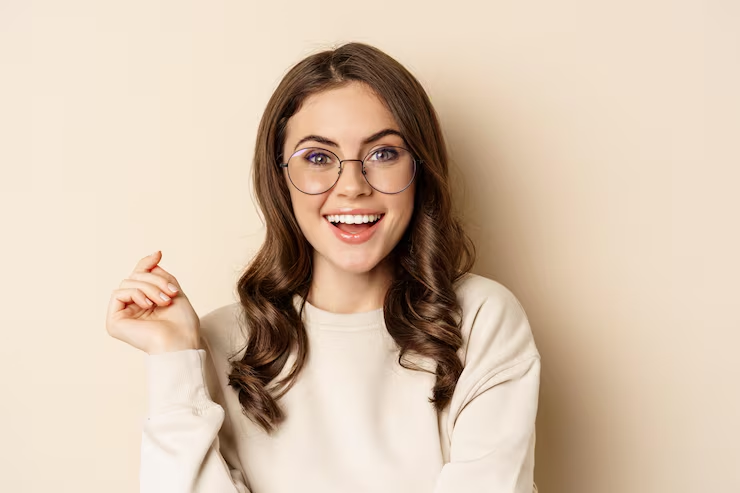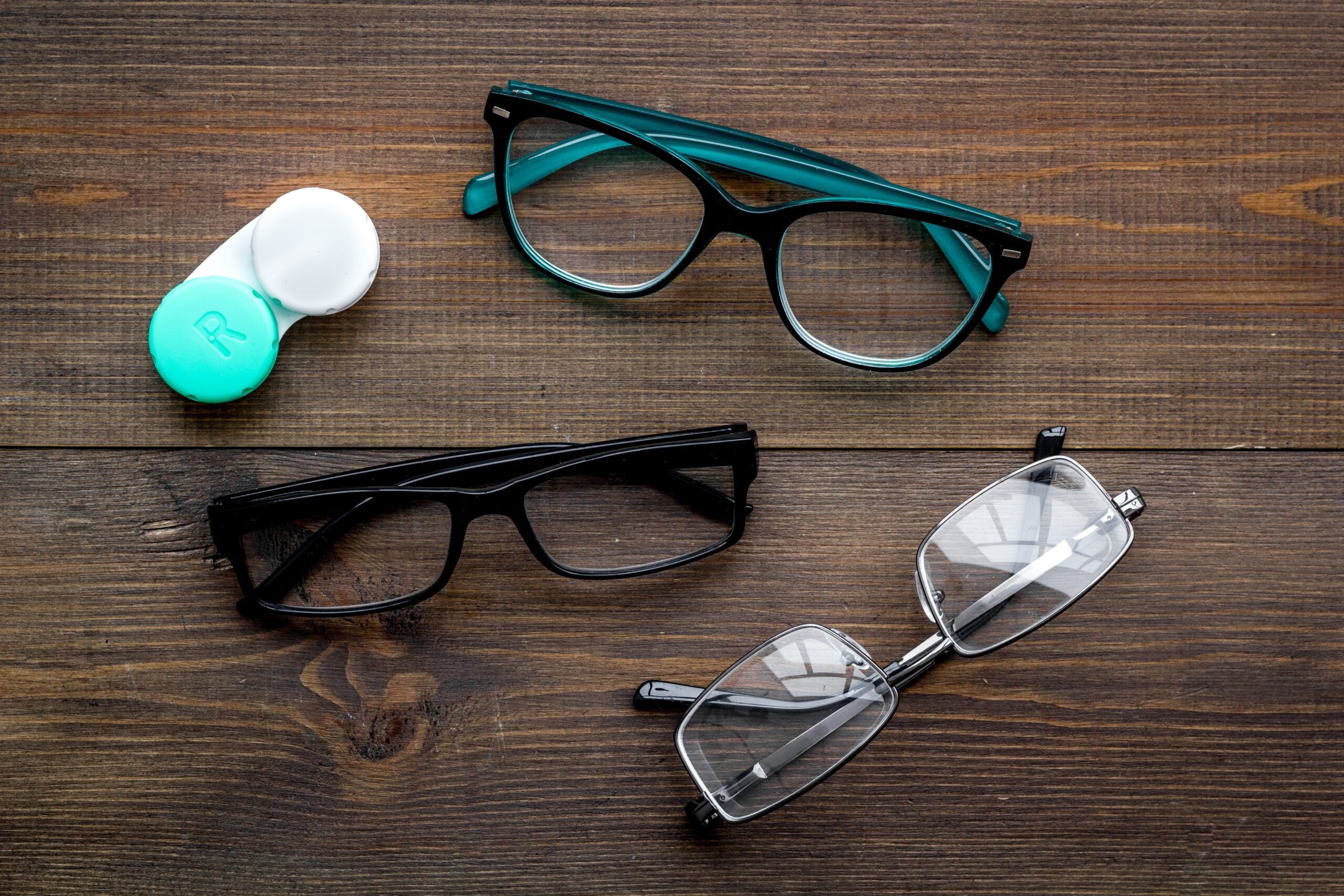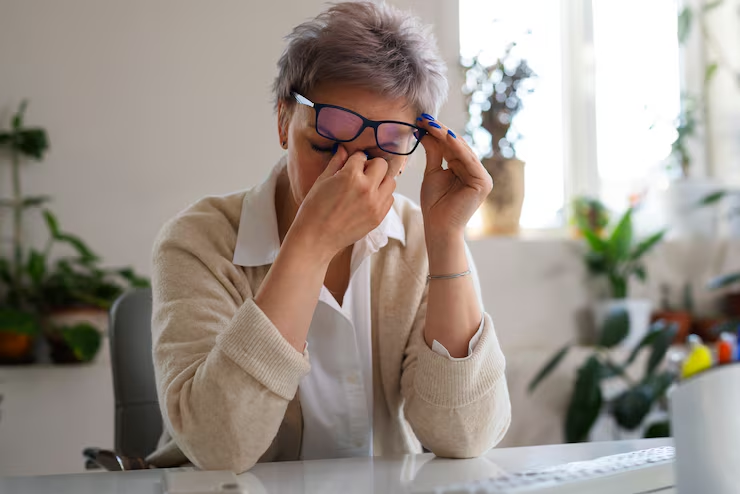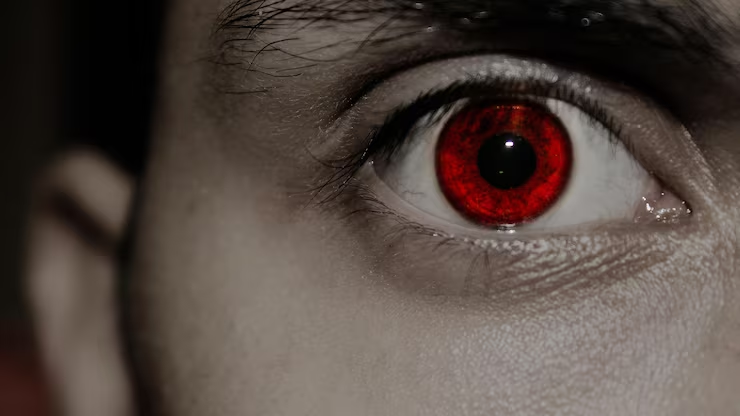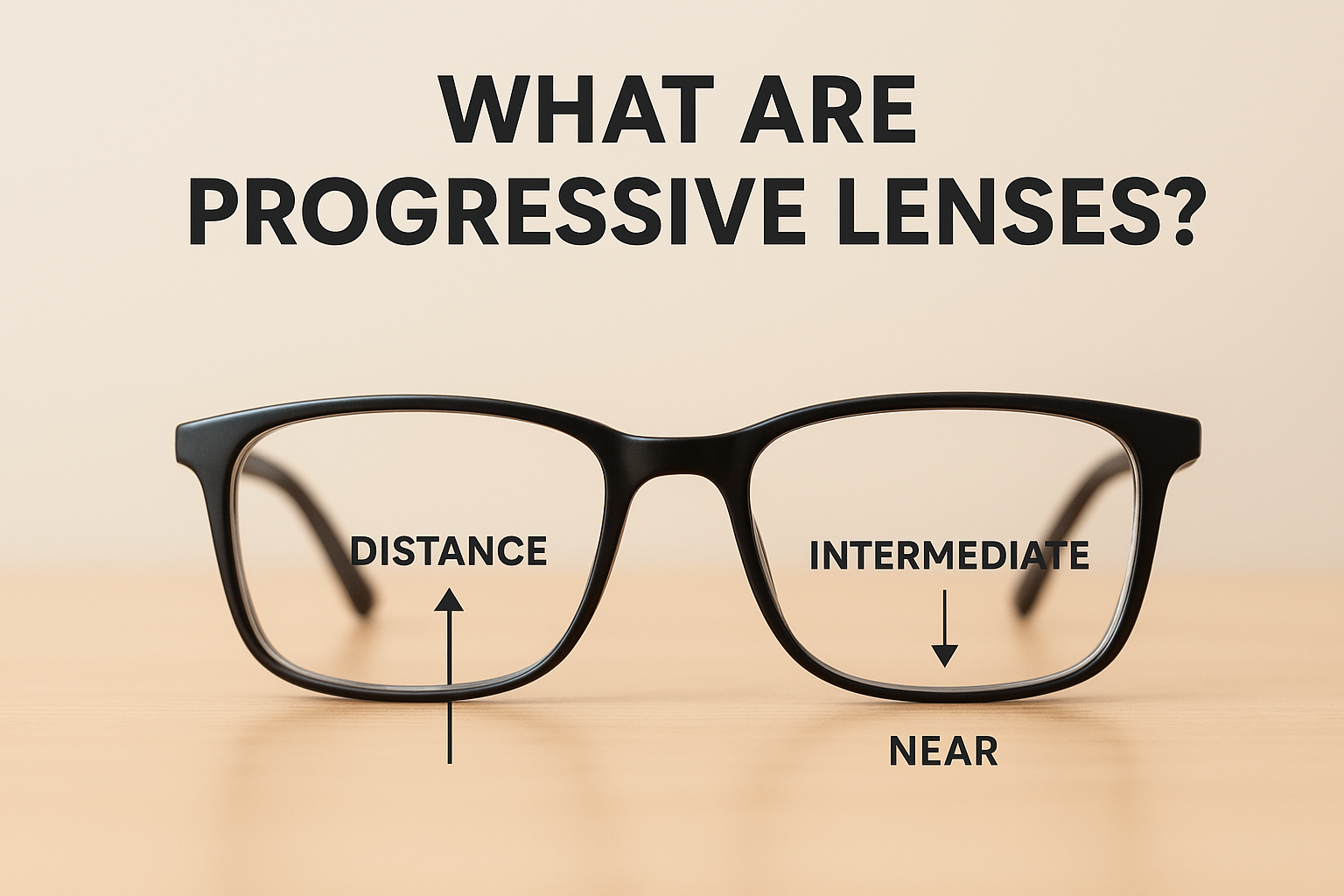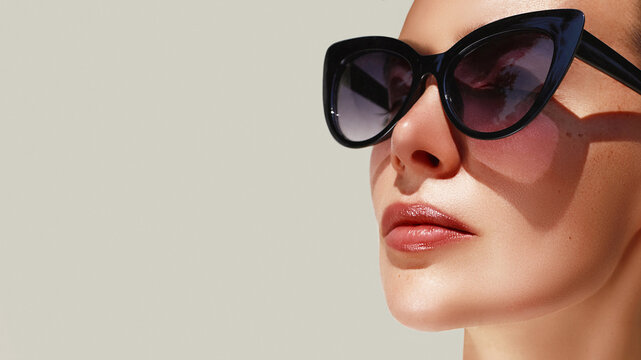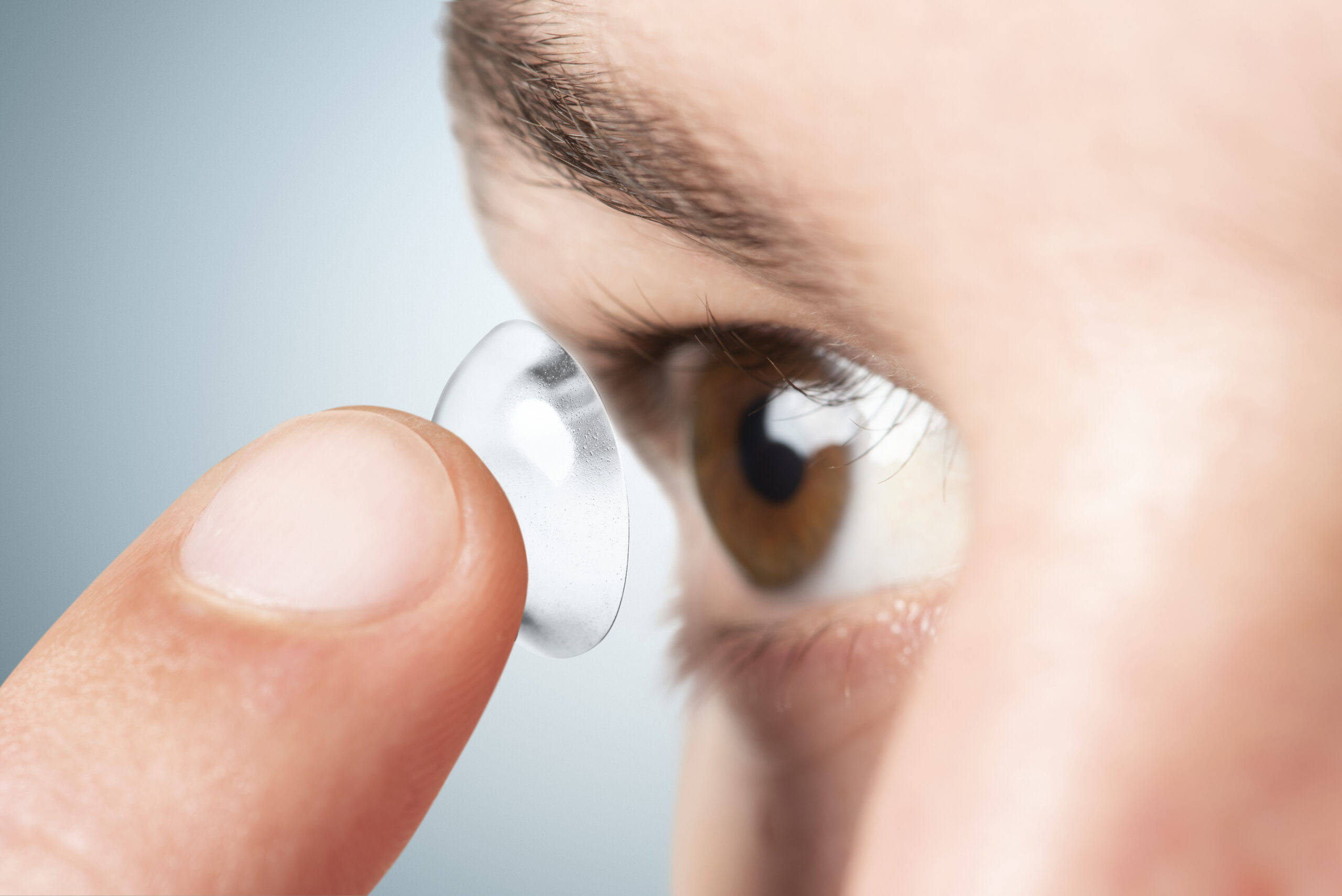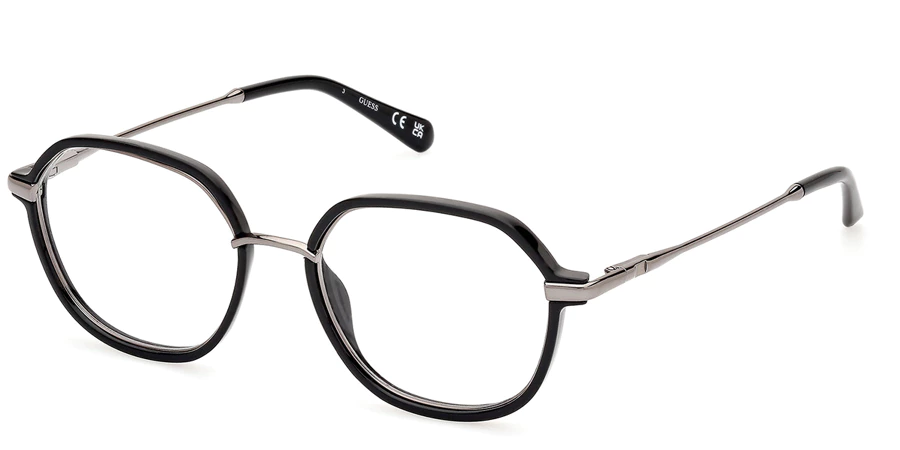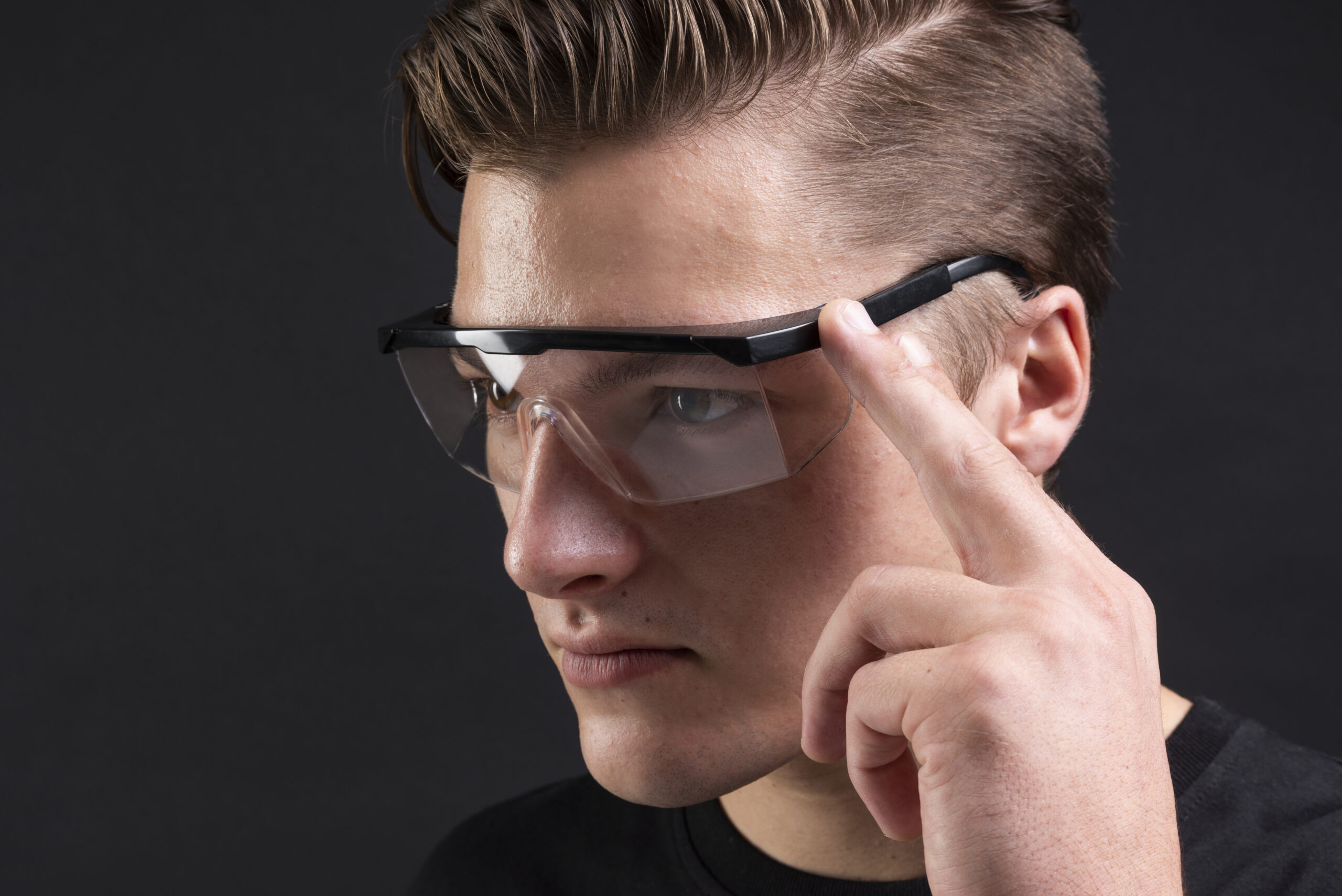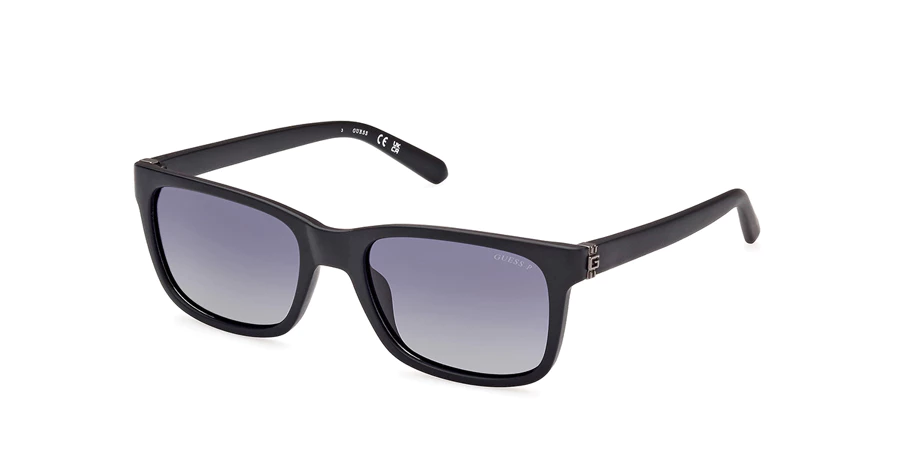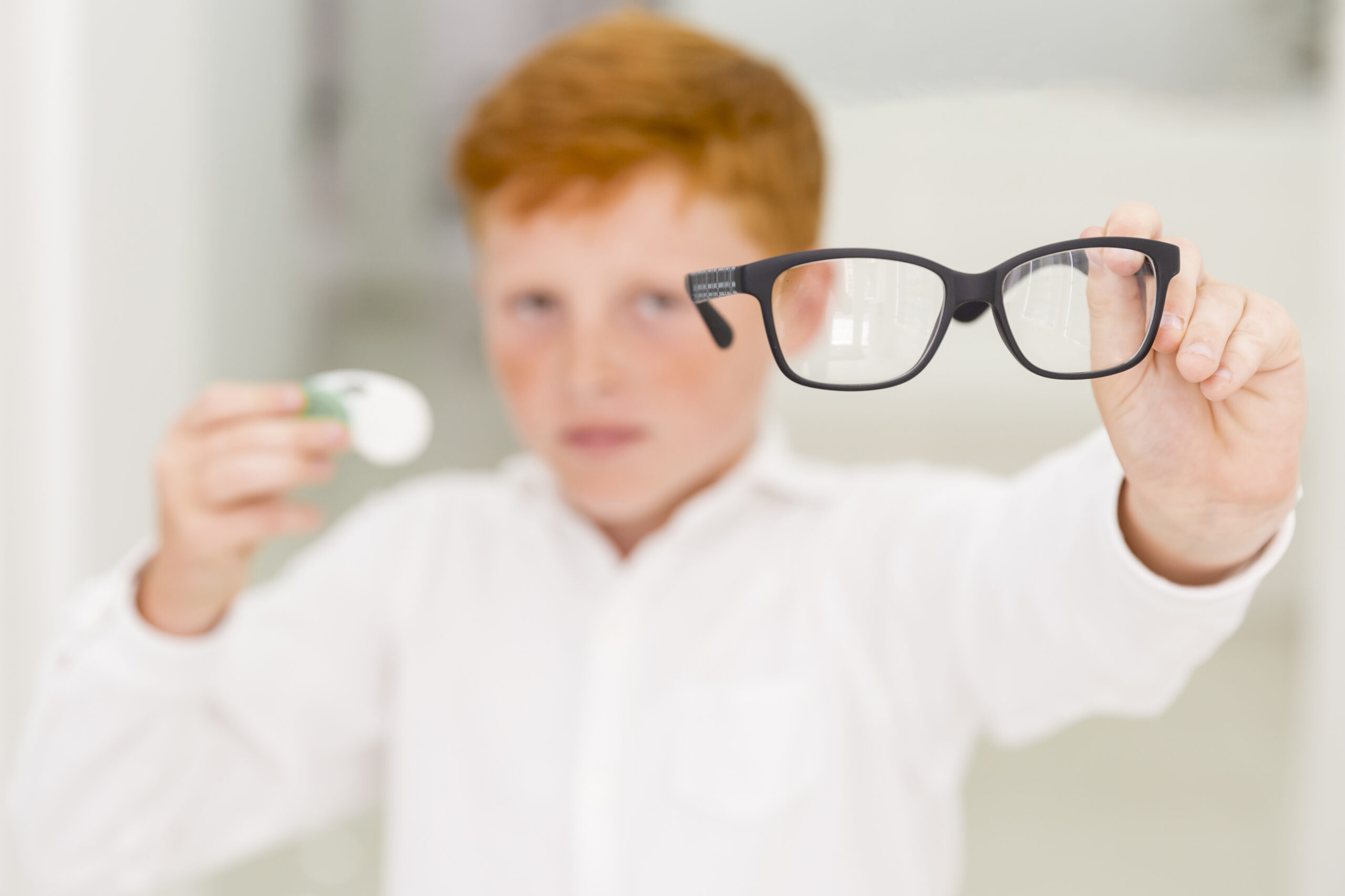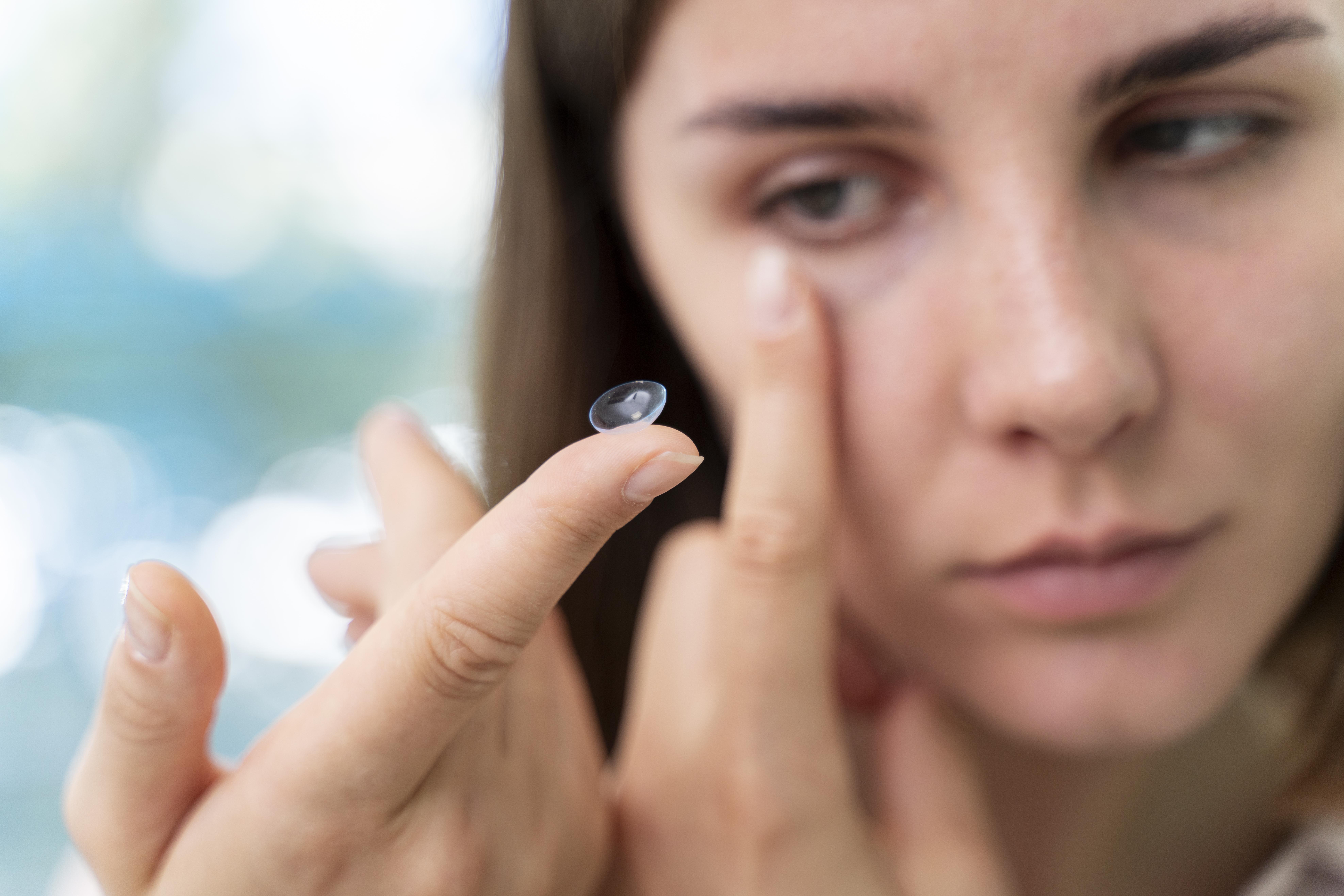As we grow older or experience changes in our vision, many people find that single-vision glasses are no longer enough to see clearly at both near and far distances. For this reason, multifocal lenses such as progressive lenses and bifocal lenses have become popular options. These specialized lenses help correct vision at multiple focal points in a single pair of glasses. Choosing the right type can improve your visual comfort and quality of life, especially for everyday activities like reading, driving, or working on a computer. What Are Progressive Lenses? Progressive lenses, sometimes called “no-line bifocals,” are advanced eyeglass lenses that provide a seamless transition between multiple vision zones without any visible dividing line. The top portion of the lens is optimized for distance vision, the middle portion for intermediate tasks such as computer work, and the bottom portion for near vision like reading. This smooth gradient of power helps your eyes move naturally between different distances, giving you a more modern and versatile visual experience compared to traditional lenses. What Are Bifocal Lenses? Bifocal lenses are the classic solution for people who need both distance and near vision correction in one pair of glasses. These lenses contain two distinct optical zones separated by a visible line. The top zone helps you see objects that are far away, while the bottom zone is dedicated to near tasks like reading. Because of this clear distinction between zones, bifocal lenses can be easier to adapt to for some wearers, especially those who are familiar with the design from past use. Key Differences Between Progressive and Bifocal Lenses The main difference between progressive lenses and bifocals lies in how they handle vision correction across distances. Progressive lenses offer a seamless transition from distance to intermediate to near vision, without any visible lines on the lens. In comparison, bifocal lenses provide only two distinct vision zones near and far separated by a visible line, with no intermediate correction. Because of their design, progressive lenses often deliver a more natural visual experience, reducing the feeling of switching focus between different distances. Advantages of Progressive Lenses Bifocal lenses continue to be a practical choice for many individuals who mainly require clear distance and near vision correction. Because they have a clear dividing line, they can be simpler to get used to, especially for first-time multifocal wearers. Additionally, bifocals are often more budget-friendly compared to progressive lenses, making them a cost-effective option for those who do not need intermediate vision correction. Drawbacks and Considerations Progressive lenses typically require a short adaptation period as your eyes adjust to the smooth change in vision zones, and they are generally more expensive than bifocal lenses. Some wearers may also notice slight peripheral distortion in lower-quality progressives. On the other hand, bifocal lenses do not provide intermediate vision correction, which can make tasks like computer use and close-up work less comfortable. The visible line on bifocal lenses is sometimes considered less modern in appearance, and the sudden shift between zones can create an image jump effect for some wearers. How to Decide Which One Is Right for You Choosing between progressive lenses and bifocals depends on your lifestyle, visual needs, and budget. If you want a single pair of glasses that can handle distance, intermediate, and near vision with a sleek look, progressive lenses might be the better choice. However, if you are budget-conscious, prefer a familiar design with a clear split between vision zones, and don’t need intermediate correction, bifocals can be a practical option. Consider how you spend your day whether you work a lot on screens, drive often, or read frequently and consult with an eye care professional to determine the best fit for your eyes. Both progressive lenses and bifocals offer effective solutions for multifocal vision needs, but each comes with its own set of advantages and considerations. Progressive lenses provide seamless vision and a modern appearance, while bifocals remain a simple and affordable classic choice. Understanding the differences and how they align with your daily activities will help you make an informed decision and enjoy clearer, more comfortable vision every day. Follow us : LinkedIn , Instagram , twitter , facebook
Timeless Tradition to Trendy Frames Inside Eyemastr Collection
Eyewear has evolved far beyond simple vision correction. Today, your glasses tell a story about your personality, style, and even your cultural roots. The Eyemastr Heritage Collection captures this evolution from honouring timeless traditions to embracing contemporary fashion trends that make every frame a statement piece. A Celebration of Cultural Legacy Eyemastr isn’t just about selling eyewear—it’s about celebrating vision, culture, and style all in one place. While Eyemastr’s website showcases a wide range of eyewear including sunglasses, contact lenses, and prescription glasses, the brand also draws inspiration from deeper cultural expressions. The Heritage Collection is one such example where classic design philosophies and motifs come alive in frame form. Each frame in this collection is crafted with attention to tradition, echoing the artistic motifs, architectural patterns, and heritage inspired shapes that have stood the test of time. These traces of culture are thoughtfully blended into eyewear that feels just as contemporary as it is classic. The Essence of Timeless Tradition At the heart of the Heritage Collection lies an appreciation for the past. Traditional design influences—such as architectural symmetry, ornamental patterns, and classic silhouettes—make these frames stand out. These elements give the collection a sense of depth and character, making each frame more than just a fashion accessory. They’re a nod to the artistry that shaped design aesthetics long before modern eyewear trends took centre stage. This blend of heritage and style connects young trendsetters and seasoned eyewear lovers alike to a legacy that’s visible every time they put on their glasses. It resonates especially with those who want glasses that say something about who they are and where fashion is headed. From Vintage Inspirations to Modern Frames What makes the Heritage Collection special is its seamless transition from the vintage to the modern. These frames borrow from classic eyewear shapes that have been popular through many eras—such as round opticals, bold rectangular silhouettes, and refined metal rims—yet reimagine them in contemporary finishes. Imagine a frame with a subtle geometric pattern inspired by traditional art or a sleek metal finish that speaks to modern minimalism. These frames marry the best of both worlds: the charm of classic designs with the flair of today’s fashion sensibilities. The result is eyewear that feels rooted in history yet thoroughly contemporary. Growing Eyewear Trends and Heritage Appeal Eyemastr as a brand thrives on the idea that eyeglasses are now pivotal fashion indicators, not just functional tools. Trends such as oversized frames, translucent designs, blue light protection lenses, and minimalist metal shapes are shaping how people view eyewear in everyday life. These trends are visible across many modern collections and highlight a shift toward frames that blend fashion with utility. The Heritage Collection taps into this by incorporating classic elements—such as refined shapes or subtle patterns—while still embracing modern outlooks. Whether you prefer a sleek metal frame with a timeless silhouette or an acetate frame with unique accents, these pieces cater to both trend-loving and tradition-respecting wearers. Quality Craftsmanship Meets Contemporary Comfort A heritage frame doesn’t just look good—it’s built to last. Each Eyemastr Heritage Collection frame is designed with precision engineering and premium materials that ensure durability, comfort, and daily usability. These frames use lightweight metals and high-quality acetate that keep them comfortable throughout long hours of wear without compromising on strength. Moreover, attention to detail ensures that features such as hinge quality, frame balance, and lens compatibility meet modern expectations. Whether you’re wearing them for work, travel, or leisure, these frames offer the perfect balance between reliable function and stylish form. How to Style Your Heritage Frames For Everyday Wear Choose frames with subtle patterns or classic colors for a professional yet stylish look that pairs well with office outfits or daily errands. For Weekend Style Go bold with frames that have unique motifs or modern accents. These styles bring personality to casual ensembles. For Formal Moments Opt for sleek metal rims or minimalist designs that elevate your outfit without overpowering it. Accessorizing with your wardrobe and personal taste can truly make heritage frames reflect your identity, proving they aren’t just eyewear—they’re a fashion statement that’s rooted in culture and crafted for today’s world. Eyemastr’s Heritage Collection beautifully bridges the gap between timeless tradition and trendy frame styles. By combining cultural inspiration with modern design sensibilities and quality craftsmanship, this collection offers eyewear that’s both meaningful and fashionable. Whether you value classic aesthetics or contemporary edge, these frames are designed to elevate your everyday look while honouring the artistry that inspires them. Explore the Heritage Collection on Eyemastr and find frames that celebrate history, style, and vision—all in one exquisite designFollow us: LinkedIn , Instagram , Twitter , Facebook
How to Improve Eyesight Naturally ?
Do you worry about your increased eye power ? If yes, you are not alone in this. Every spectacles wearer worries about their eyesight. Also, this worry constantly encourages them to look for ways to reduce eye power. So, can you minimize eye power? Fortunately, you can. However, it is not easy. You have to put much effort into this. But all these efforts might prove worthwhile for you if you hate putting on spectacles or lenses. So, how to improve eyesight? Several ways can help with this. With this blog, we aim to share the most effective tips for improving eyesight. So, continue reading to learn how to improve eyesight naturally. How to Improve Eyesight Naturally? Increasing your vitamin and mineral intake is the most effective and natural way. Minerals like zinc and vitamins A, C, and E significantly help improve eyesight. It is a proven way that has helped numerous individuals to improve eye power. Vitamins and minerals prevent macular degeneration. For these nutrients, you could try to include the following foods in your diet- You must also include food sources rich in omega-3 fatty acids, like flax seeds and salmon. These significantly contribute to better eye health. Colorful fruits and vegetables also help improve eye health. Below are the most effective ways to improve your eye power naturally. Enhance Your Vitamin and Mineral Intake Increasing your vitamin and mineral intake is the most effective and natural way. Minerals like zinc and vitamins A, C, and E significantly help improve eyesight. It is a proven way that has helped numerous individuals to improve eyesight naturally. Vitamins and minerals prevent macular degeneration. For these nutrients, you could try to include the following foods in your diet- You must also include food sources rich in omega-3 fatty acids, like flax seeds and salmon. These significantly contribute to better eye health. Colorful fruits and vegetables also help improve eye health. Include Carotenoids in Your Diet Improving eyesight is a collective effort. You need to include several nutrients in your diet for this. Carotenoids like zeaxanthin and lutein are found in the retina, so you must include them in your diet. These carotenoids can be found in broccoli, eggs, leafy green vegetables, and zucchini. However, if it is not possible for you to have these sources, you can also take supplements. They will help protect your macula by enhancing pigment density and absorbing blue and ultraviolet light. Stay Fit Exercise is good for each part of your body, and your eyes are no exception. So, do not think exercising will be beneficial for just your body shape. It is also necessary for your eyes. Overweight people are more prone to Type 2 Diabetes, which causes damage to tiny blood vessels in the eyes. That is why healthcare professionals suggest exercising daily to reduce weight and minimize the chances of Type 2 Diabetes. Manage Chronic Conditions Diabetes is just one disease that can affect your vision. Several other disorders might decrease your eyesight, including multiple sclerosis and high blood pressure. Therefore, if you suffer from such conditions, you must get the proper treatment to prevent further damage to your vision. Such diseases result in chronic inflammation in your body from head to toe. If this inflammation affects your optic nerve, it can damage your vision. So, get timely treatment for such chronic conditions. Reduce Screen Time The problem of weak eyesight is rapidly increasing in the present world. But why? The primary reason for this increase is the enhanced use of digital screens. Whether for entertainment or work, every individual spends hours on digital screens, which negatively impacts their vision. This is why one must minimize the use of these screens. However, if you still have to spend hours on them for work or education, follow the 20-20-20 rule. Wear Protective Goggles Another crucial way in this guide to improve eyesight naturally is to wear protective eyewear. Whether playing a sport, riding a bicycle, or working in your workplace, there are hazards for your eyes, so protective eyewear is essential to protect your eyes from damage. Sharp objects can cause harm to your eyes. So, you have to protect them from such objects at any cost. This also includes wearing sunglasses whenever you step out in the sun or drive a car during the day. The harmful UV rays coming from the sun are damaging to your eyes. Therefore, you must wear sunglasses to block it from reaching your eyes. Quit Smoking You must have heard that smoking is harmful to your heart and lungs. But do you know it is even bad for your eyes, hair, skin, teeth, and around every other body part? Yes, this is true. Smoking can raise the chances of age-related macular degeneration and cataracts. Therefore, if you smoke regularly, you must quit it today for your good health. In the first hours of quitting, your body will start healing from the tobacco-induced harm. So, quit it today to reduce your eye power. Having a high power and wearing a pair of spectacles is not only bad for your appearance. You can even get irritated from wearing them due to comfort issues. That is why you must follow all the above tips on how to improve your eyesight. They will help you improve your eyesight and might reduce eye power. However, they might not always work or provide you with a 6/6 vision. But, they will help you with improving your eyesight to some extent.
Sun, Style & Swag: How to Choose the Perfect Sunglasses for Kids
Children love the sun, but their eyes? Not so much! Whether they’re running around the park or just tagging along on errands, their delicate eyes need just as much protection as their skin. That’s where a good pair of sunglasses for kids is a must-have for every parent. At Eyemastr, we know that finding the perfect pair for your little one isn’t just about looking cute. It’s about comfort, durability, and, most importantly, top-tier UV protection. Our collection is designed for your little star! But how do you pick the right sunglasses for your little star? Well, here’s the answer! Why Do Your Kids Need Sunglasses? Children’s eyes are more sensitive than ours. Prolonged exposure to harsh UV rays can lead to long-term damage. The solution? High-quality sunglasses that shield their eyes. You wouldn’t let your child spend a day at the beach without sunscreen, right? The same care should be given to their eyes. According to studies, excessive UV exposure in childhood can lead to prolonged damage. By introducing sunglasses early on, you’re helping build a habit that will protect their vision for years to come. Moreover, less squinting means fewer headaches and less eye strain. Thus making it easier for your child to focus and enjoy their activities without discomfort. What to Look for in Kids’ Sunglasses? Now that we know why they’re essential, let’s talk about how to choose the right pair. Here’s what to look for: ➢ UV Protection & Lens Quality When shopping for sunglasses for kids, 100% UV protection is non-negotiable. It’s not just about shielding their eyes. It’s also about making sure they see the world clearly without squinting or discomfort. Every pair at Eyemastr meets the highest safety standards, so you know their little eyes are in good hands. ➢ Comfort is Key Ever bought your child something adorable, only for them to refuse to wear it? Sunglasses are no different. A great pair of glasses should sit snugly on their face without slipping or pinching. Look for adjustable frames or lightweight designs that won’t feel heavy. Remember, the easier and more comfortable they are to wear, the more likely your child is to keep them on! ➢ Built to Last Kids can be a little rough. One minute, they’re wearing their sunglasses. The next, they’re on the ground. That’s why durability matters. Eyemastr sunglasses are built to handle all the adventures, tumbles, and surprises that childhood brings. ➢ Style that Kids Love We all know that if kids don’t like something, they won’t wear it. Period. That’s why style matters. From bold colours and fun prints to sleek, sporty designs, we have something for every child. Why Choose Eyemastr? Here’s why parents love Eyemastr ➢ Maximum UV Protection Every pair is engineered to keep harmful rays out. ➢ Lightweight, Ergonomic Design No slipping, no discomfort, just a perfect fit. ➢ Built Tough Our sunglasses are made to survive playground adventures and accidental drops. ➢ Trendy & Fun Styles that kids actually want to wear. ➢ Exclusive Offer Get 10% off on your second order because one pair is never enough! Pro Tips for Keeping Sunglasses on Your Child Even with the perfect pair, some kids might resist wearing sunglasses at first. Here are a few tricks to make them a part of their daily routine: ➢ Lead by example Kids love to imitate adults, so if they see you wearing sunglasses, they’ll be more likely to wear theirs. ➢ Start early The sooner sunglasses become part of their outdoor gear, the more natural it will feel. ➢ Use a strap A soft, adjustable strap can keep sunglasses in place and prevent them from getting lost. ➢ Praise & reward Compliment them on how cool they look or offer small incentives for wearing them regularly. Ready to Upgrade Their Style & Protection? Shop at Eyemastr! Your child deserves the best when it comes to eye protection. At Eyemastr, we’ve got the perfect blend of safety, comfort, and style. So, why wait? Visit our website or your nearest E store today and grab a pair (or two) for your little trendsetter. Don’t forget to take advantage of our special discount on your second purchase!
All You Must Know About the Different Types of Lenses for Glasses
The world of eyewear is quite diverse. You might be aware of the different styles and shapes of frames. But do you know that there are various types of lenses for glasses, too? Yes, there are. For every purpose of a pair, a different lens type is available. To decide the best pair of glasses for your eyes, you must choose the right lens type. Selecting the most suitable lens type will significantly impact your vision. So, no matter why you need a pair of eyeglasses, choose the lens type carefully. Eyemastr understands the importance of the right lens type for your vision. Therefore, we have come up with this blog to introduce you to the different types of lenses. So, start reading below to uncover them all. Types of Lenses Based on Material One of the first factors to categorize lenses is based on their material. They can be classified into the following types. Glass Glass lenses provide unparalleled vision clarity. But, a major drawback of these lenses is their heavy weight. Also, these lenses are easy to break. Earlier only the glass lenses were used for vision correction. However, these lenses now have much safer substitutes made with substantial materials. Plastic Another type are the plastic lenses. These were introduced in the 1940s and are still appreciated for their durability. They are half the weight of glass lenses. Also, plastic lenses are priced lower than the glass lenses. Another advantage of these lenses is that they do not break easily. Polycarbonate Polycarbonate lenses were created in the 1970s. Since their introduction, these lenses have become quite popular. Their weight is less than even the plastic lenses. They also possess high-impact resistance. Such features make them the perfect choice for children’s glasses. They are also popularly used for safety glasses as they can bear significant wear and tear. They can be built with UV protection features. Trivex Next on the list of different types of lenses are the trivex lenses. These lenses are made with a similar plastic as used for manufacturing polycarbonate lenses. Trivex lenses are thinner and very lightweight. Compared to polycarbonate lenses their weight is much less and they have higher impact resistance. High-Index Plastic Eyeglasses for strong prescriptions usually contain lenses made with high-index plastic. Their higher refractive index makes them suitable for strong prescriptions. They are also appreciated for their lightweight and slim design. Lenses are also categorized into different types based on prescription. Following are the varying types of lenses for glasses, depending on the prescription. Single Vision Single vision lenses offer the largest vision field. They are mostly used for prescription eye glasses for men and women with near sightedness or farsightedness. These are also used for astigmatism corrective eyeglasses. Single vision lenses are the cheapest lenses. Bifocals Another type of lens based on prescription is the bifocals. These lenses have two different powers. They are also known as multifocal lenses, as they assist people with multiple vision issues. They are made with two distinct sections. Bifocals are capable of correcting nearsightedness and farsightedness at the same time. Trifocals Next on the list are trifocal lenses for eyeglasses for women and men. The purpose of these lenses is almost similar to those of bifocals. However, they have an additional section when compared to bifocals. In addition to correcting nearsightedness and farsightedness, trifocal lenses also have a section to correct intermediate vision that helps look at objects within an arm’s distance. Progressives Progressive lenses are the following type of lenses that are the perfect alternative for those who are unable to adjust to trifocals and bifocals. These lenses offer the same level of vision correction. Also, they make adjusting between prescriptions easier. Prism Prism lenses are prescribed to individuals who face severe binocular issues. These lenses are suitable for the eyes that are unable to look in the same direction when at rest. People with double vision use these lenses popularly. However, prism lenses cannot be used to correct refractive issues. How to Find the Best Lenses for Glasses? In the diverse eyeglasses world, how will you find suitable lenses for your glasses? It is pretty simple. You just need to ensure the following factors are met: Summing Up As you are now aware of the various types of lenses for glasses, it will be easier for you to pick the right kind. However, we suggest you always consult your optician to find the suitable type. Also, it is of utmost importance to ensure that the lenses you choose fulfil their purpose and are comfortable to wear.
How to Transition from Contact Lenses to Stylish Frames?
Are you tired of spending countless mornings poking around in your eye without a mirror trying to slap a contact lens into place? While contacts have their advantages, there comes a time when you might be craving a little extra flair. Enter stylish frames: those little workhorses perched on your nose that can instantly elevate your confidence, double as a fashion statement, and save you from the dreaded lens hunt. Switching from contacts back to frames might sound like a backward move, but trust me, it’s more of a stylish sprint forward. Whether you’re itching for a new look, fed up with the daily contact hustle, or just want peace of mind on a late-night Netflix binge, this guide will help you glide smoothly from contact gear to frame-chic. Why Make the Switch? Okay, let’s be honest: sliding on contacts was liberating the first dozen times. But over time, you might notice dry eyes, irritation, or that nagging feeling that something’s just… not right. Plus, who actually enjoys carrying around solution bottles, bulky cases, and that sense of dread when you realize you left everything at home? Glasses, on the other hand, are the ultimate one-and-done: slip ‘em on, and you’re ready. Also, modern lens tech offers super-thin, lightweight options with anti-glare coatings so you can binge TikTok without smudges. Beyond convenience, glasses let you express yourself: bold colours, sleek silhouettes, aviator vibes or classic wayfarers; your eyewear can become an extension of your personal style. And if you’re eco-conscious, reducing contact-waste plastic is a nice bonus. But the real kicker? Glasses give your eyes a breather. No more rubbing or over-wearing contacts right before bed. Let your eyes rehydrate naturally and you might notice fewer headaches and clearer vision all around. Choosing the Perfect Frames So you’re convinced; now comes the fun part: frame shopping. Begin with understanding your face shape. Here’s a quick cheat sheet: Beyond shape, think about frame material. Metal frames feel delicate and lightweight, while acetate (plastic) offers a broader palette of colours and patterns. If you’re indecisive, spring hinges add durability and flexibility; no more pockets full of bent arms. At Eyemastr, we’ve got everything from minimalist metal builds to vibrant acetate masterpieces. The trick is to pick something that feels like you on your best day, go bold if you’re feeling adventurous, or play it safe with a timeless tortoiseshell. Either way, you’ll never look back. Adjusting to Frames Comfortably Wearing glasses 24/7 after years of a zero-lens lifestyle can take some getting used to. Those arms could leave marks behind, and the weight on your nose might feel foreign at first. But here’s the thing: once you break in a new pair (and maybe tweak the nose pads), they become second nature. Begin with wearing your glasses for short stints, maybe an hour or two to let your nose and ears acclimate. If they slide down, consider a tighter fit around the temples or a visit to your optician for a quick adjustment. No shame in asking: a small tweak can make a huge difference in comfort. You might also notice slight differences in your vision; longer hours on computer use may require progressive or blue-light-filter lenses. Soon enough, those frames will feel like an invisible extension of yourself. Styling Tips for Glasses Wearers Glasses don’t just correct vision; they elevate outfits. Here are some styling hacks: Don’t forget that sunglasses are also frames! Transition lenses offer the best of both worlds, —clear indoors, shaded outdoors; so you stay stylish and protected without a second pair. Make a Smooth Transition from Contact Lenses to Stylish Frames with Eyemastr Ready to give your eyes a stylish upgrade? Whether you’re stepping away from contacts for good or just mixing it up, Eyemastr has your back (and your face!). Browse our latest collection of frames; each one handpicked to bring out your best features while keeping comfort at the forefront. Shop now, find your perfect pair, and embrace a world where vision meets vogue. Your eyes deserve to look as amazing as they see. Click here to explore our collection and start your frame journey today! Follow us : LinkedIn , Instagram , Twitter , Facebook
Understanding and Managing Your Eye Allergies
What Are Eye Allergies? Eye allergies, also known as allergic conjunctivitis, occur when your eyes react to certain irritants or allergens in the environment. These allergens are usually harmless for most people, but if you are sensitive to them, your immune system overreacts and releases histamines. This leads to redness, itching, swelling, and watery eyes. Common allergens that trigger eye allergies include pollen, dust mites, mold spores, pet dander, and smoke. People often confuse eye allergies with eye infections, but allergies are not contagious and usually flare up when you come into contact with specific triggers. Common Symptoms of Eye Allergies Eye allergy symptoms can vary from mild discomfort to severe irritation. The most common symptom is persistent itching, which can be so strong that people tend to rub their eyes frequently. Along with this, redness occurs due to the inflammation of the conjunctiva. Many people also experience watery or teary eyes because the tear glands produce more fluid to flush out allergens. Swollen eyelids, burning sensation, light sensitivity, and a gritty feeling in the eyes are also common. If your symptoms increase during certain seasons, you may have seasonal allergies, while year-round symptoms often indicate indoor allergies. What Causes Eye Allergies? Eye allergies can be triggered by various outdoor and indoor allergens. Seasonal triggers include pollen from trees, grass, and weeds, which become especially active during spring and summer. Indoor triggers include dust mites, mold spores, and pet dander. In addition to allergens, certain irritants like cigarette smoke, perfumes, pollution, or harsh chemical fumes can also irritate the eyes. These triggers do not cause a true immune reaction but can worsen symptoms for people who already have sensitive eyes. How Eye Allergies Are Diagnosed Eye allergies are usually diagnosed based on symptoms and triggers. If your symptoms persist or become severe, an eye specialist may examine your eyes using a slit lamp to check for inflammation. Sometimes, allergy testing may be recommended to identify specific allergens causing your reaction. This helps create a targeted treatment plan, especially for people with chronic or severe symptoms. Effective Ways to Manage Eye Allergies Managing eye allergies begins with identifying and avoiding your triggers as much as possible. Staying indoors on days when pollen levels are high, keeping windows closed, and using air conditioning can help reduce exposure to outdoor allergens. Indoors, regular cleaning, vacuuming, and keeping your bedding dust-free can minimize dust mites and pet dander. Using an air purifier is also beneficial for people with year-round allergies. When going outside, wearing sunglasses can help prevent pollen and dust from entering your eyes. Home Remedies for Eye Allergy Relief Several simple remedies can provide quick and natural relief from eye allergy symptoms. Applying a cold compress over your closed eyes helps reduce swelling and soothes redness. Rinsing your eyes gently with clean, cold water can wash out allergens and relieve irritation. Using artificial tears or lubricating eye drops can help flush the eyes and reduce dryness and discomfort. It is important to avoid rubbing your eyes, as this can worsen inflammation and increase irritation. Medical Treatment Options If home remedies are not enough, various over-the-counter and prescription treatments are available. Antihistamine eye drops help reduce itching by blocking histamines, while mast-cell stabilizer drops help prevent allergy symptoms when used regularly. Combination eye drops containing both antihistamines and mast-cell stabilizers are helpful for people with frequent symptoms. For more severe cases, doctors may prescribe corticosteroid eye drops, but these should always be used under professional supervision. Oral antihistamines may also help reduce overall allergy symptoms, especially if you have both eye and nasal allergies. When You Should See a Doctor You should consult an eye specialist if your symptoms do not improve with basic treatment or if they become more severe. Pain, blurry vision, excessive sensitivity to light, or thick discharge from the eyes may indicate an infection or another eye condition that needs medical attention. Long-term use of the wrong eye drops, especially steroid-based ones, can be harmful, so professional guidance is important. Children, elderly patients, and people who wear contact lenses should also be extra careful and seek professional advice when symptoms persist. Preventive Lifestyle Tips for Long-Term Control Good eye hygiene and smart lifestyle habits can significantly reduce the frequency of eye allergy flare-ups. Make sure to wash your hands and face regularly, especially after coming from outdoors. Keep your living space clean and dust-free, and wash your bedding frequently in hot water to kill dust mites. If you have pets, keep them well-groomed and avoid letting them sleep on your bed. Staying hydrated and getting enough sleep also support healthy eyes and reduce inflammation. Most importantly, avoid rubbing your eyes, as it can worsen symptoms and damage delicate eye tissues. Eye allergies are common but manageable with the right awareness and preventive care. By understanding your triggers, maintaining clean surroundings, using appropriate eye drops, and seeking medical advice when necessary, you can keep your eyes healthy and comfortable. Whether your symptoms occur seasonally or throughout the year, proper care and timely treatment can help you enjoy clear, irritation-free vision. Taking proactive steps today ensures better eye comfort and long-term eye health. If you’re experiencing persistent eye allergy symptoms or need expert guidance, feel free to contact Eyemastr for professional eye care support and personalized solutions. Follow us : LinkedIn , Instagram , Facebook , Twitter
Decoding the Mystery of Red Eyes
Red eyes are one of the most common eye concerns people experience, yet the cause behind them can vary from harmless irritation to serious medical conditions. When the white part of the eye turns red, it indicates inflammation or dilation of tiny blood vessels on the eye’s surface. Many individuals feel anxious seeing a sudden change in eye appearance, especially when redness is accompanied by pain, itching, or blurred vision. Understanding what triggers red eyes is crucial for adopting the right treatment and preventing further damage. Although red eyes are often temporary, ignoring them for too long may worsen the condition or hide an underlying eye disease. Environmental Irritation and Allergies Exposure to everyday irritants is one of the most common reasons behind red eyes. Dust, smoke, pollution, strong fragrances, and chlorine in swimming pools can easily disturb the eye surface, leading to redness and watering. Seasonal allergies also play a major role, especially when pollen counts are high. People allergic to pet dander and mold may experience eye redness throughout the year. When the eye comes into contact with these triggers, the immune system responds with inflammation, causing visible redness. Taking proper precautions such as avoiding irritants and using lubricating drops often helps restore comfort and clarity. Dry Eyes and Digital Screen Fatigue In today’s digital age, excessive screen exposure causes millions of people to suffer from dry eye syndrome. Staring at screens reduces the blinking rate, preventing natural lubrication and leading to dryness, irritation, and redness. Air-conditioned rooms and long hours of reading intensify the issue even more. Dry eyes are not just uncomfortable; they can drastically affect productivity and overall eye health. Individuals who spend extended hours on mobile phones, laptops, or gaming should consciously take breaks, blink more often, and use hydrating eye drops to support moisture balance and prevent persistent redness. Infections of the Eye Eye infections such as conjunctivitis (commonly known as pink eye), keratitis, and blepharitis can also cause noticeable redness. Conjunctivitis is often triggered by bacteria, viruses, or allergies and spreads easily through physical contact and shared personal items. Keratitis usually results from injury, improper contact lens hygiene, or fungal exposure, while blepharitis is related to inflammation of the eyelids. Infection-related redness is typically accompanied by symptoms like sensitivity to light, discharge, or blurred vision. Delaying professional treatment in such cases may worsen the infection and threaten long-term eye health. Contact Lens Misuse Wearing contact lenses for extended hours or failing to clean them properly can irritate and inflame the eyes. Many wearers also sleep with lenses on, restricting oxygen flow and allowing bacteria to accumulate. This can lead to red eyes, discomfort, and in serious cases, corneal infections. Contact lens wearers should maintain proper hygiene, replace lenses on time, and give their eyes regular breaks. Switching to high-quality lenses and using sterile solutions also helps reduce irritation and the risk of redness. Underlying Medical Conditions Certain medical conditions contribute to chronic or recurring red eyes. Glaucoma, uveitis, and ocular hypertension can trigger inflammation and damage internal eye structures. Autoimmune diseases such as rheumatoid arthritis and lupus may affect the eyes as well. Redness associated with sharp pain, sudden vision changes, or nausea should never be ignored, as it may indicate an eye emergency. Identifying the cause early helps prevent complications and ensures that the right treatment is provided. When Should You See an Eye Specialist? Occasional red eyes caused by fatigue or environmental factors typically improve with rest, hydration, and proper eye care. However, persistent redness lasting more than a few days, especially when accompanied by discomfort, discharge, or blurred vision, requires professional evaluation. Early diagnosis helps protect vision and reduces the risk of long-term damage. Eye specialists can identify whether the redness is due to dryness, infection, allergies, or a more serious eye condition and offer targeted treatment for fast relief. Red eyes are a signal that your eyes are under stress, irritated, or affected by an underlying condition. Paying attention to the symptoms and understanding common causes helps you choose the right care approach before the issue escalates. Maintaining good eye hygiene, reducing screen fatigue, avoiding irritants, and reaching out to an eye-care professional when needed are the best steps to preserve eye comfort and long-term vision health. Healthy eyes play a vital role in daily life, and addressing redness quickly ensures that your eyes remain clear, refreshed, and protected. If you are experiencing persistent redness, discomfort, or uncertainty about your eye health, Eyemastr is here to help you get back to clarity and comfort. Our goal is to support your vision with trusted eye-care guidance, helpful resources, and awareness about common eye problems. Your eyes deserve the right care, and Eyemastr is committed to making eye wellness simple, accessible, and stress-free. Explore more eye-care insights and take a step toward healthier vision with Eyemastr. Follow us : LinkedIn , Instagram , Facebook , Twitter
What Are Progressive Lenses?
What Are Progressive Lenses Progressive lenses are special eyeglass lenses designed to help people see clearly at all distances without switching between multiple pairs of glasses. These lenses offer a natural and gradual shift in vision from near to intermediate to distance. Unlike bifocal or trifocal lenses there are no visible lines on progressive lenses which makes them more comfortable and modern in appearance. They look like normal single vision lenses but provide three in one vision correction. People who are above forty often experience presbyopia which makes it difficult to focus on close objects. Progressive lenses solve this problem by giving clear vision for reading computer use and distance views in one single pair of glasses. How Progressive Lenses Work Progressive lenses are designed with a smooth transition of power from the top of the lens to the bottom. The upper part of the lens helps with distance vision such as driving or watching far objects. The middle section supports intermediate vision such as using a computer or looking at a phone at arm’s length. The lower part of the lens is used for near vision such as reading books or checking documents. This gradual change allows the eyes to shift naturally between different viewing zones. The design reduces the need to remove glasses frequently and makes daily life more convenient. Types of Progressive Lenses There are different types of progressive lenses created to suit various needs and lifestyles. Standard progressive lenses are the most common and offer a smooth transition between all viewing distances. Premium progressive lenses provide a wider field of view and reduce distortion making them more comfortable for daily use. Office progressive lenses are designed mainly for near and intermediate tasks such as computer work and reading and are best for people who spend long hours indoors. Custom progressive lenses are tailored to the wearer’s face shape frame size and lifestyle for maximum comfort. Every type offers a different experience allowing users to choose the one that fits their routine. Benefits of Progressive Lenses Progressive lenses offer many benefits that make them a preferred choice for people with presbyopia. They remove the need for multiple pairs of glasses which makes life simpler and more comfortable. They also look more stylish because there are no visible lines on the lenses. People find them helpful for multitasking because they allow smooth vision changes while working reading or driving. Progressive lenses provide a natural viewing experience that reduces eye strain and supports better posture since you do not need to move your head unnaturally to see clearly. Overall they bring convenience clarity and modern design together in one lens. Who Should Use Progressive Lenses Progressive lenses are ideal for people who have difficulty seeing close objects due to age related changes in vision. Most people start experiencing presbyopia after the age of forty and progressive lenses become a practical solution. They are also suitable for people who do not want to switch between reading glasses and distance glasses throughout the day. Anyone who works on a computer spends time reading or engages in tasks that require frequent focus changes can benefit from these lenses. They are also a great choice for those who prefer a clean and modern look without visible lens lines. Price of Progressive Lenses The cost of progressive lenses depends on the type design brand coating and customization level. Standard progressive lenses are usually more affordable while premium and custom lenses may cost more due to advanced technology and wider viewing zones. The price can also increase when adding features like blue light protection anti reflective coating or scratch resistant coating. Although progressive lenses are more expensive than basic single vision glasses they provide greater value through convenience comfort and multifunctional use. Investing in a good pair of progressive lenses ensures better vision and long term comfort. Common Challenges and Adjustment Period Some people need a short period of time to adjust to progressive lenses. This is completely normal because the eyes and brain must get used to the new way of viewing different distances. You may feel slight blur on the sides or need to move your head slightly to find the right focus area. With regular use the adjustment becomes easy and natural. Wearing the lenses consistently and choosing high quality designs helps reduce discomfort. After the adjustment period most users find progressive lenses extremely comfortable and efficient for everyday life. Use Cases of Progressive Lenses Progressive lenses are suitable for many daily activities. They are perfect for reading books working on laptops using mobile phones driving watching television and performing office tasks. People who travel frequently benefit from the all in one functionality since they do not need separate glasses for reading and distance. They are also great for professionals who switch between screens documents and meetings throughout the day. Whether indoors or outdoors progressive lenses support smooth vision changes that fit into every part of daily routine. Progressive lenses offer a modern and convenient solution for clear vision at all distances. They provide comfort style and practicality for anyone experiencing presbyopia or facing challenges with near and intermediate vision. With various types price options and use cases these lenses make daily activities easier and more enjoyable. If you are looking for high quality progressive lenses that match your lifestyle you can explore Eyemastr for the latest designs and expert guidance. Follow us : LinkedIn ,Instagram , twitter , facebook
5 Hottest Sunglasses Trends for 2026
As we look toward 2026, the world of eyewear is buzzing with exciting new sunglasses trends that perfectly blend cutting-edge style with essential functionality. Browsing through the hottest sunglasses and picking the perfect shades for you isn’t just about style; it’s also about safeguarding your vision. This guide will dive deep into the fashion sunglasses poised to dominate the year, emphasizing why UV protection sunglasses and eye protection sunglasses are non-negotiable. Get ready to discover your next iconic pair that champions both aesthetics and health. Trend #1: Make a grand statement with oversized sunglasses. The reign of oversized sunglasses continues into 2026, but with a refined and more architectural twist. These aren’t just big; they’re thoughtfully designed statement pieces that exude confidence and mystery. We’re seeing a shift towards more structured, often rectangular or subtly geometric oversized frames, moving beyond the purely curvilinear forms of previous years. Trend #2: Oval sunglasses, a stylish nod to retro chic. Oval sunglasses are making a strong comeback, channelling a distinct retro sunglasses vibe with a modern edge. These frames offer a softer alternative to sharp angles, providing a universally flattering shape that balances various facial features. Expect both slim, minimalist oval frames and slightly chunkier acetate versions, often in unexpected colours or patterns. Trend #3: Choose cat-eye sunglasses for timeless allure – reimagined. Cat-eye sunglasses come with refreshing twists in 2026, offering variations that range from subtly upward-swept corners to dramatically exaggerated wings. This year, we’ll see creative interpretations with unique finishes, dual-tone frames, and even delicate embellishments that redefine this iconic silhouette. The focus is on playful elegance and feminine power. Trend #4: Sporty meets high-fashion with wrap sunglasses. Trend #4: Sporty meets high-fashion with wrap sunglasses. For 2026, wrap sunglasses are making a significant crossover from performance eyewear into mainstream fashion. These sporty frames offer maximum coverage and a sleek, aerodynamic look with a futuristic twist. Expect bold colours, mirrored lenses, and innovative materials, blending athletic utility with a high-fashion sensibility. This trend aligns perfectly with the growing emphasis on fitness, wellness, and keeping an active lifestyle. Trend #5: Thin metals deliver minimalist sleekness. Embodying understated yet stylish sophisticated, these metal sunglasses are a key style for shades-wearers in 2026. Characterized by their delicate-looking construction, they offer slim wireframes in gold, sliver, rose gold, or matte black. Shapes range from updated aviator sunglasses to refined rounds and subtle geometric outlines, prioritizing lightness and a barely-there feel. Why UV protection is non-negotiable. While chasing the hottest trends, never compromise on the sunglasses’ eye protection. Your eyes are susceptible to damage from harmful ultraviolet (UV). This is why certified UV protection sunglasses are paramount. How to choose your perfect pair of sunglasses. Selecting the right pair of shades involves a balance of style and substance in your process: By combining your desire for the best & latest with a commitment to keeping your eyes safe, you’ll find a pair that’s both effortlessly you and supremely protective. Find the best in style and protection with us. Choosing the perfect pair of sunglasses for 2026 is an exciting journey that blends personal expression with vital health considerations. At Eyemastr, we’re committed to bringing you the hottest sunglasses trends of 2026 alongside must-have UV protection. Looking for sunglasses that match the 2026 trends while giving your eyes the protection they deserve?Explore Eyemastr’s exclusive collection of premium sunglasses designed for style, comfort, and complete UV400 protection. Whether you love oversized, oval, cat-eye, wrap, or minimalist metal frames we have something crafted just for you.For expert guidance or to find your perfect pair, contact Eyemastr today. Reach out to us anytime our team is here to help you choose eyewear that fits your style and safeguards your vision. Follow us : LinkedIn , Instagram Twitter, Facebook
Eco-Friendly Glasses Materials Pair Truly Sustainable?
Choosing eyewear today is no longer only about fashion or comfort. Many people now want glasses that are kind to the environment and support a sustainable future. Eco friendly glasses materials are becoming an important part of the eyewear industry as brands and customers both look for options that cause less harm to nature. This blog explores whether these materials are truly sustainable and what makes them a good choice for eco conscious users. Understanding Eco Friendly Glasses Materials Eco friendly glasses materials are those that come from natural sources or recycled elements. These materials are designed to reduce pollution and waste while providing durable quality. Many eyewear brands now offer frames made from plant based plastics, recycled metals, wood and even biodegradable material. The idea behind these materials is to reduce the use of harmful chemicals and traditional plastic which take years to break down. Different Types of Sustainable Eyewear Materials There are several materials used for making eco friendly glasses. Plant based acetate is one of the most popular options. It is created from natural fibers and is known for being flexible and comfortable. Recycled plastic is another common material that helps reduce the amount of plastic waste thrown into the environment. Bamboo and wood frames have also become popular because they have a naturally stylish look and come from renewable resources. Recycled metal frames use previously used metals which reduce the need for fresh mining and lower carbon emissions. Are These Materials Truly Sustainable The idea of sustainability depends on how the material is sourced and how long the product lasts. Eco friendly materials are more sustainable compared to traditional plastics because they do not release harmful chemicals and are easier to recycle. Plant based acetate uses natural ingredients and breaks down faster than regular acetate. Recycled plastic uses already existing waste which keeps plastic away from oceans and landfills. Wood and bamboo are renewable as long as companies follow responsible harvesting. Recycled metals reduce energy consumption and provide long lasting durability. Environmental Impact of Eco Friendly Eyewear Eco friendly materials clearly reduce environmental harm. Recycled plastic lowers the need for new plastic manufacturing which saves energy and reduces pollution. Plant based materials reduce the use of petroleum based products. Wood and bamboo have a lower carbon footprint when sourced responsibly. Even the manufacturing of sustainable eyewear focuses on lowering waste and energy use. Many companies also follow responsible packaging practices to reduce their environmental impact even further. Comfort and Style in Sustainable Glasses Eco friendly glasses do not compromise on style or comfort. In fact many people prefer the natural look of wood or bamboo frames as they offer a unique appearance. Plant based acetate frames come in various colors and shapes and feel lightweight and smooth on the skin. Recycled metal frames are strong and durable which makes them a good everyday choice. These materials show that sustainable eyewear can be trendy stylish and long lasting. Challenges in Eco Friendly Eyewear Production Although eco friendly materials are a better choice they still come with some challenges. The manufacturing process for plant based acetate can sometimes be more expensive which increases the final cost for customers. Wood frames may not be as flexible as plastic frames. Recycled plastic quality can vary depending on how well it is processed. However most of these challenges can be reduced with new technology and better recycling methods. As more people choose sustainable products companies are improving their processes to make them more efficient. How to Choose Truly Sustainable Eyewear When choosing eco friendly glasses it is important to check the material used and the brand’s sustainability practices. Look for eyewear brands that use certified recycled materials and responsibly sourced wood or bamboo. Check if the company explains their manufacturing process and environmental goals. Also choose a frame that suits your face shape and daily use so that it lasts longer. A long lasting product is always more sustainable because it reduces the need for frequent replacements. The Future of Sustainable Eyewear The demand for eco friendly glasses is increasing every year. As customers become more aware of environmental issues brands are working harder to produce eyewear that is natural safe and long lasting. With new innovations in material science the eyewear industry is moving towards more biodegradable options and carbon neutral production methods. The future of eyewear will be more eco conscious and stylish at the same time. Eco friendly glasses materials are not just a trend. They are an important step towards a cleaner and greener future. These materials reduce waste save energy and offer a stylish comfortable option for everyday use. While there are still some challenges the benefits are far greater. Eco friendly eyewear materials can be considered truly sustainable when companies follow responsible practices and customers make conscious choices. If you are looking for stylish durable and sustainable eyewear options you can connect with Eyemastr. Eyemastr offers high quality frames that combine modern design with eco friendly materials. For more information or to explore the best sustainable eyewear collection you can contact Eyemastr today. Follow us : Linkedin , Instagram , facebook , Twitter
Best Eyeglasses for Office Work & Long Screen Hours- Eyemastr
Spending long hours on a laptop, desktop, or mobile screen has become a part of daily life. Whether you work in an office or from home, constant screen exposure can lead to eye strain, headaches, blurred vision, dryness, and poor focus. The right pair of eyeglasses can protect your eyes and improve comfort, productivity, and overall eye health. Here’s a complete guide to the best eyeglasses for office work and long screen hours, along with the top materials and lens types you should consider. 1. Blue-Light Blocking Eyeglasses – Essential for Digital Eye Protection Blue-light glasses are one of the best investments for office workers. They help reduce digital eye strain by filtering harmful blue light emitted by screens. Benefits: 2. Anti-Glare (AR) Coated Eyeglasses – Clear Vision Without Reflections Anti-glare eyeglasses come with a special coating that eliminates reflections from computer screens and artificial lights. Why they’re perfect for office: 3. Lightweight Frames – Comfort for All-Day Wear Comfort matters when you’re wearing glasses for 8–10 hours a day. Lightweight frames reduce pressure on your nose and ears, making them ideal for office routines. Best lightweight materials: 4. Large Frame Eyeglasses – Wider Field of Vision A larger lens area makes it easier to view screens without needing to tilt your head frequently. This supports better posture and reduces neck strain. Ideal for: 5. Blue-Violet Light Filtering Eyeglasses – Advanced Screen Protection These special lenses block both blue-violet light and UV rays, offering premium eye comfort for people who stare at screens all day. Benefits include: How to Choose the Best Eyeglasses for Office Work Keep these tips in mind when selecting your next pair of eyeglasses: Choosing the right eyewear can significantly improve your daily comfort and support healthier vision—especially if you spend hours in front of digital screens. Working long hours in front of screens can strain your eyes, but the right eyeglasses make a huge difference. From blue-light protection to lightweight frames and anti-glare coatings, there are many options designed specifically for office professionals and digital users. Upgrading to the right pair ensures better vision, improved comfort, and enhanced productivity every day. Ready to upgrade your office eyewear? Follow Eyemastr and explore our premium collection of screen-friendly eyeglasses designed for comfort, clarity, and all-day protection! Stay connected with us:- Facebook , Instagram , X(Twitter) , LinkedIn
Do Contact Lenses Really Improve Eyesight? Here’s What You Should Know
Contact lenses for eyesight have come a long way—from simple experimental glass shells to today’s advanced, ultra-comfortable vision-correction lenses. The journey of contact lenses is not only fascinating but also essential in understanding how they’ve evolved into a safe, reliable, and highly popular alternative to eyeglasses. These early lenses were thick, uncomfortable, and far from practical, offering very few of the benefits modern contact lenses provide. How Modern Contact Lenses for Eyesight Are Made Today’s contact lenses are designed using advanced technology and safe, breathable materials such as soft plastics and silicone hydrogels. While the exact process varies based on lens type, the general manufacturing steps include: 1. Digital Lens Designing A detailed computer-aided design (CAD) creates the exact shape and curvature of the lens to ensure a precise fit. 2. Creating the Lens Blank The mold is used to form an unfinished “blank” made from the chosen lens material. 3. Precision Shaping With a Lathe The blank lens is refined using high-precision machinery that grinds and polishes it to achieve the perfect thickness and curvature. 4. Adding a Moisture-Retaining Coating A thin wetting agent is applied to improve comfort and keep the lens hydrated. 5. Cutting & Edging for a Custom Fit The lens is trimmed to match the shape of the eye, and edges are polished for smoothness and irritation-free wear. 6. Sterilization & Packaging Finally, the lens undergoes sterilization in a clean, controlled environment to ensure complete safety before packaging. What Are the Benefits of Contact Lenses for Eyesight? Modern contact lenses offer numerous advantages, making them one of the most preferred choices for vision correction: Since lenses sit directly on the eye, they offer a wider field of view with no frames blocking your sight—great for driving, sports, and daily activities. Soft contact lenses feel natural and are often more comfortable than eyeglasses, especially during physical activity. Lenses are invisible when worn, allowing your natural appearance to shine through—perfect for people who prefer not to wear glasses. No fogging, no sliding, no raindrops on your glasses. Contact lenses are easy to manage and ideal for active lifestyles. You can wear contact lenses while: Contact lenses are designed to correct many eye conditions, including: No need to worry about choosing frames that suit your face shape—contact lenses eliminate all frame hassles. So, Can Contact Lenses Actually Improve Your Eyesight? Contact lenses correct your eyesight while you’re wearing them, but they do not permanently improve your eye power or reverse vision problems. They work similarly to eyeglasses but provide sharper, more natural vision due to their direct placement on the eye. However, modern lenses offer: For many users, this creates the experience of better eyesight throughout the day. Contact lenses for eyesight are a modern, safe, and highly effective solution for millions of people worldwide. With incredible comfort, versatile usage, and superior visual clarity, they are often a preferred choice over traditional eyeglasses. Find Your Perfect Contact Lenses – Start Shopping at Eyemastr! Stay connected with us:- Facebook , Instagram , X(Twitter) , LinkedIn
Blue Light Protection Glasses: The Invisible Shield Your Eyes Need
The Modern Dilemma We live in a world powered by screens—phones, laptops, tablets, TVs, and even smart appliances. But here’s the uncomfortable truth:The same technology we rely on every day may be quietly straining our eyes. With digital usage skyrocketing, blue light exposure has become a growing concern. Research shows the average American now spends over 10 hours a day in front of digital devices. That’s nearly half of your day exposed to high-energy blue light—something our eyes were never designed to handle. This constant exposure has been linked to: If your eyes feel exhausted, you’re not imagining it—your screens are working overtime, and so are your eyes. Understanding the Problem: What Exactly Is Blue Light? Blue light is a naturally occurring, high-energy visible (HEV) light on the spectrum—powerful, intense, and capable of penetrating deep into the eye. While the sun is our primary source of blue light, our digital devices now add significant artificial exposure on top of it. Studies also show that children absorb even more blue light than adults due to clearer lenses and developing eyes. That means screen time is even more impactful for younger generations. 6 Powerful Reasons to Start Using Blue Light Blocking Glasses Blue light glasses aren’t just a trend—they’re a smart, science-backed solution for protecting your eyes in a digital-first world. The Science Behind Blue Light Glasses At EyeMastr, our blue light protection glasses are engineered using advanced filtering lens technology that targets high-energy blue wavelengths from screens. These lenses: Whether you’re working, studying, gaming, or scrolling, EyeMastr empowers your eyes with the protection they deserve. Protect Your Eyes—Feel the Difference Blue light glasses aren’t just about reducing glare—they directly support long-term eye wellness. Less Digital Eye Strain Symptoms like dry eyes, blurred vision, headaches, and fatigue often decrease significantly when you start wearing blue light protection glasses regularly. Better Sleep Quality Blue light tricks your brain into thinking it’s still daytime. This suppresses melatonin—the hormone that regulates sleep.By blocking excess blue light, especially in the evening, EyeMastr glasses support more natural, restful sleep. Enhanced Productivity When your eyes feel less strained, you can work longer, focus better, and stay comfortable throughout your day. Blue Light Glasses Are Taking Over Pop Culture From gamers to influencers to on-screen characters, blue light glasses have become a symbol of digital-era wellness. Creators, tech professionals, and celebrities are increasingly using blue light eyewear—not just for health benefits, but for style and screen-ready confidence. Shield Your Eyes with Style — Only at EyeMastr If you’re looking for glasses that combine advanced protection with flawless design, EyeMastr delivers the perfect blend. Why EyeMastr Blue Light Glasses Stand Out: At EyeMastr, we believe protection shouldn’t come at the cost of style. Our collection helps you look great while keeping your eyes healthy—whether you’re at work, in class, gaming, or scrolling your feed. In today’s screen-filled world, blue light protection isn’t optional—it’s essential. Long hours of digital exposure can take a toll on your eyes, sleep, and overall well-being. EyeMastr Blue Light Protection Glasses offer a simple, stylish, and science-backed way to safeguard your vision—every single day. Your eyes work hard for you. Isn’t it time you protected them? Explore the EyeMastr collection today and experience the difference for yourself. Stay connected with us:- Facebook , Instagram , X(Twitter) , LinkedIn
Top Lightweight Eyeglass Frames for All-Day Comfort
Wearing eyeglasses all day shouldn’t feel heavy or uncomfortable. If your frames leave marks on your nose, cause headaches, or feel bulky, it’s time to switch to lightweight eyeglass frames designed for long-lasting comfort. Today’s modern eyewear combines style, durability, and feather-light materials to give you a smooth, irritation-free wearing experience. Here’s a complete guide to the best lightweight eyeglass frame options that offer maximum comfort from morning to night. 1. Titanium Frames – Strong, Flexible & Ultra-Light Titanium is one of the top choices for people seeking both comfort and durability. These frames weigh significantly less than traditional metal frames and are resistant to bending, corrosion, and wear. Why they’re great:Extremely lightweightFlexible yet strongHypoallergenic for sensitive skin 2. TR90 Frames – Flexible & Comfortable 2. TR90 Frames: Flexible & Shock-Resistant TR90 frames are made from a special thermoplastic material known for their flexibility and feather-light feel. They are perfect for people who lead an active lifestyle or need glasses that stay comfortable throughout the day. Benefits:Super flexibleNatural, comfortable fitLightweight and durable 3. Acetate Frames – Stylish & Lightweight Acetate offers a premium aesthetic without the heaviness of regular plastic frames. They come in bold colors and patterns while still being lighter and more comfortable. Why people love them:Fashionable and modernLightweight premium feelSkin-friendly material 4. Minimalist Rimless & Semi-Rimless Frames If you want glasses that feel almost invisible, rimless and semi-rimless designs are ideal. These frames reduce pressure on your nose and ears, making them a top choice for professionals and minimalists. Features:Ultra-lightweightSleek, modern lookComfortable for long hours 5. Thin Metal Frames – Simple, Sleek & Light Thin stainless-steel or alloy frames offer the perfect balance of simplicity and comfort. They’re lightweight, durable, and great for people who prefer a simple yet elegant eyewear style. Advantages: Light on the face Long-lasting Minimalist and classy How to Choose the Right Lightweight Frames To ensure maximum comfort, consider the following: Lightweight frames are an investment in comfort, eye health, and style — making them perfect for everyday wear. Explore premium lightweight eyeglass frames at Eyemastr and find your perfect pair today! Stay connected with us:- Facebook , Instagram , X(Twitter) , LinkedIn
Flexible Smart Glasses: Where Innovation Meets Comfort
Smart eyewear is transforming the way we see and interact with the world. These advanced glasses blend digital technology with everyday vision, offering hands-free access to navigation, fitness data, communication, and immersive experiences. With built-in sensors, cameras, processors, and wireless connectivity, smart glasses deliver real-time information directly within your line of sight—merging the physical and digital worlds effortlessly. Types of Smart Eyewear How Smart Eyewear Works Smart glasses use micro-displays, motion sensors, AI software, and voice or touch controls to project digital content onto the lenses. They can be operated through voice commands, gestures, touch controls, or even connected devices like smartphones and wearables. Where Smart Glasses Excel The Future of Smart Eyewear With improved speech recognition, energy-efficient chips, and solar-powered designs, smart eyewear is becoming more intuitive and long-lasting. As technology evolves, these glasses will redefine how we work, learn, and experience the world. If you’re exploring the latest smart eyewear trends, Eyemastr is your destination for innovative, stylish, and future-ready vision solutions. Explore Smart Eyewear at Eyemastr and experience the future today! Stay connected with us:- Facebook , Instagram , X(Twitter) , LinkedIn
How to Understand Eyeglass Frame Measurements
A Peek into the Past of Eyewear What started as simple glass lenses designed to correct nearsightedness has evolved into a world of sophisticated eyewear built for clarity, comfort, and style. Modern eyeglass frames reflect advancements in material science, design innovation, and personal fashion expression—making them essential tools and stylish accessories at the same time. Eyeglasses are often seen as fashion statements, but behind every trendy frame lies a blend of art and precision. The structure of each frame is engineered with great detail—taking into account lens strength, facial anatomy, and long-term comfort. At Eyemastr, we emphasize this harmony of science and style, ensuring your frames look great and feel even better. Featherlight Style: Redefining Comfort with Lightweight Eyeglass Frames Lightweight frames have become a popular choice for daily wearers seeking all-day comfort. Materials like titanium, acetate, and TR-90 offer durability without the bulk, making them ideal for those who prioritize comfort along with aesthetics. At Eyemastr, you’ll find a curated collection of lightweight eyeglass frames designed to reduce pressure on the nose, ears, and temples—perfect for long hours of use. Factoring in the Numbers: Understanding Eyeglass Frame Dimensions Every pair of glasses comes with three crucial measurements, and knowing what they mean can help you make the right choice. 1. Lens Width Lens width measures the horizontal diameter of each lens. This value determines how much of your face the frame covers and influences both the look and functionality of your glasses. 2. Bridge Width This is the distance between the lenses. Bridge width affects how the glasses rest on your nose and plays an essential role in comfort and stability. A proper bridge width prevents sliding or pinching. 3. Temple Length Temple length refers to the arms of the frame—extending over and behind your ears. The right temple length ensures your eyeglasses remain secure and comfortable throughout the day. Mind the Measurements: Why Fit Matters An ill-fitting pair of glasses may look stylish but can cause discomfort, headaches, or even affect your vision alignment over time. Oversized frames may be trendy, but if they don’t align with your facial width, they will constantly slide down your nose. Proper measurements ensure your glasses stay in place, feel comfortable, and support healthy vision. Getting It Right: The Importance of Professional Guidance Navigating the world of eyeglass frame sizes and styles can feel overwhelming. This is where expert guidance becomes essential. Professional optometrists and eyewear specialists—like those behind Eyemastr—help you choose frames that match your prescription, lifestyle, and unique facial features. With their support, you can confidently pick eyewear that blends function with fashion. Understanding eyeglass frame dimensions empowers you to make smarter, more comfortable, and more stylish choices. Whether you’re shopping for lightweight frames, classic designs, or modern chasma styles, Eyemastr offers a wide range of eyewear crafted with precision and creativity. Browser the latest eyewear collections at Eyemastr and find your perfect fit today. Stay connected with us:- Facebook , Instagram , X(Twitter) , LinkedIn
How to Choose the Perfect Sunglasses for Your Face Shape
Introduction Have you ever wondered whether your face is long, oval, round, or square — or how much your face shape truly affects how sunglasses look on you?Surprisingly, the shape of your sunglasses has a huge impact on your style, comfort, and overall appearance. Before buying your next pair of shades, it’s important to understand your facial geometry—what to avoid, what to choose, and which frames will enhance your best features. In this guide, Eyemastr brings you everything you need to pick sunglasses that fit, flatter, and feel perfect. Understanding Different Face Shapes Knowing your face shape makes choosing the right sunglasses effortless. Below is a simple breakdown of each face type: Square Face Round Face Heart-Shaped Face Diamond Face Oval Face Triangular Face To choose the best sunglasses for your face shape, you must measure your face correctly. How to Measure Your Face Shape (Face Size Guide) Understanding your face dimensions helps you select the right frame size and style. Stand in front of a mirror and follow these steps: 1. Measure Cheekbone to Cheekbone Use a measuring tape to measure across the widest point of your cheeks. 2. Measure Jawline Place the tape under one ear at the jawbone, measure across to the other side. 3. Measure Face Length Measure from your hairline to the bottom of your chin. Face Shape Analysis with the Latest AI Technology Below are expert Eyemastr recommendations: Sunglasses for Round Face Choose frames that add angles and definition: Sunglasses for Square Face Pick styles that soften strong angles: Sunglasses for Oval Face The most versatile face shape — almost all styles suit you! Sunglasses for Heart-Shaped Face Balance a broad forehead with softer frames: Sunglasses for Diamond Face Highlight the cheekbones with striking shapes: Sunglasses for Triangular Face Add balance to the narrower chin: Sunglasses for Other Face Features Small Face Choose lightweight, slim frames: Long Face Add width and proportion: Wide Face Choose frames slightly wider than your face: Sunglasses for Bald Men Enhance facial structure with bold frames: Choosing the Right Frame Colour Frame color matters as much as frame shape. For Light/Pale Skin For Medium or Dark Skin Nearly all colours look great — from bold tones to clear frames. Protection Features to Look For Before Buying Sunglasses A stylish pair is great, but protection is essential. Always choose sunglasses with: ✔ 100% UVA & UVB protection✔ UV 400 protection✔ Scratch-resistant lenses✔ Anti-glare / polarized options (optional but recommended) If you own old sunglasses, you can get UV protection checked using a UV meter. Eyemastr Is Your Perfect Eyewear Partner Eyemastr is dedicated to bringing high-quality, stylish, and affordable sunglasses that suit every face shape and lifestyle. Our mission is simple: “To make premium eyewear accessible, stylish, and comfortable for everyone.” What you get with Eyemastr: Our design and research team constantly innovates to bring fresh styles and improved comfort. Stay connected with us:- Facebook , Instagram , X(Twitter) , LinkedIn
Why Kids Need Durable Glasses: The Importance of Long-Lasting Frames
A child’s eyeglasses go through more in a single day than most adult pairs do in an entire month. They endure chalk dust in the classroom, crowded school corridors, bumpy bus rides, sweaty sports periods, and even the heavy weight of an overstuffed backpack. For kids to see clearly through it all, durable glasses aren’t a luxury—they’re a necessity. A strong, well-fitted pair prevents constant breakage, discomfort, and the habit of taking glasses off. Let’s explore the real-world challenges kids’ glasses face and what to look for when choosing frames that will survive a full school term. Where Eyeglasses Really Get Tested Glasses don’t break under display lights—they break in the chaos of everyday school life. A bent frame or scratched lens can quickly lead to blurry vision, squinting, eye strain, and headaches. Here’s what children’s glasses deal with daily: These aren’t accidents—they’re everyday moments. That’s why durability matters. Why Kids Need Strong, Long-Lasting Frames 1. Active Lifestyles Children run, jump, and play all day. Their glasses must withstand frequent drops, bumps, and impacts. 2. Learning Responsibility Kids are still developing habits of care. Durable frames reduce accidental damage from rough handling or misplacement. 3. Safety First Impact-resistant frames and lenses minimize the risk of injury during falls or sports. 4. More Value for Parents A sturdy pair of glasses cuts down on repair costs and frequent replacements. 5. Clear Vision Without Interruptions Stronger frames mean fewer breakages—and less downtime without proper vision correction. 6. Less Stress All Around Durable glasses offer peace of mind for parents and frustration-free wear for kids. Small Frames, Big Comfort At Eyemastr, our kids’ eyewear collection is crafted to make clear vision effortless and enjoyable. Each frame blends durability, comfort, and cheerful style—so children feel confident in class, at play, and everywhere in between. What Makes Our Collection Special Whether your child is getting their first pair of glasses or updating their look, our range brings together practicality and personality. Durability isn’t just a feature—it’s a combination of a strong frame, impact-resistant lenses, a secure fit, and a few good habits. Choose eyewear designed for the school week, not the display counter. When glasses stay in shape and stay comfortable, kids keep them on—seeing clearly, learning better, and living their day with confidence. Stay connected with us:- Facebook , Instagram , X(Twitter) , LinkedIn
Contact Lenses vs Eyeglasses: What’s the Right Choice for You?
Introduction Did you know the first functional contact lens was invented way back in the late 1880s? Since then, the ongoing debate between contact lenses and traditional eyeglasses has fascinated millions of vision wearers worldwide. Both have evolved immensely — offering better clarity, comfort, and design — but the question remains: which is the better choice? Globally, eyeglasses still dominate the market due to their affordability, accessibility, and long-lasting nature. Yet, recent trends reveal a steady surge in demand for contact lenses, as more people look for comfort, style, and convenience in their eyewear. Contact lenses offer a discreet, natural fit and enhance facial aesthetics without altering your appearance. Eyeglasses, on the other hand, are easy to maintain, provide eye protection, and can double as stylish fashion accessories. Choosing between the two can be tricky — especially if you’re on a budget and want the best of both worlds. So, let’s break down the pros and cons of contact lenses and eyeglasses to help you make an informed decision. Contact Lenses: Pros & Cons Pros of Contact Lenses Cons of Contact Lenses Eyeglasses: Pros & Cons Pros of Eyeglasses Cons of Eyeglasses Choosing Between Contact Lenses and Eyeglasses Ultimately, your choice depends on your lifestyle, comfort, and personal style preferences. Conclusion The contact lenses vs eyeglasses debate doesn’t have a one-size-fits-all answer. Contacts provide stealthy comfort, a wider field of vision, and lifestyle compatibility, while eyeglasses offer durability, protection, and easy maintenance. Whichever you choose, make sure it complements your lifestyle and comes from a trusted retailer like Eyemastr — your destination for affordable, stylish, and high-quality eyewear across India. Stay connected with us:- Facebook , Instagram , X(Twitter) , LinkedIn
Best Way to Clean and Care for Contact Lenses
Introduction In recent years, contact lenses have gained immense popularity among both celebrities and everyday users. According to Statista, the Indian contact lens market is projected to surpass 250 million USD by 2029 — a clear reflection of how quickly people are moving from traditional spectacles to more convenient and aesthetic options like contact lenses. Why this shift? Contact lenses offer a natural, frame-free look that enhances your appearance effortlessly. You can even experiment with different coloured lenses to complement your outfit or express your personality. Unlike eyeglasses, lenses don’t alter your face shape or affect your peripheral vision. Plus, they eliminate the discomfort of frames pressing on your nose bridge. However, contact lenses require proper cleaning and maintenance to keep your eyes healthy and your lenses long-lasting. Before we get into the care routine, let’s first understand what contact lenses are made of and why that matters. How Are Contact Lenses Made? Most contact lenses are crafted from hydrogels — special water-absorbing polymers designed to keep your eyes moist and comfortable. These hydrogels can retain up to 70–80% water, which is vital since the cornea relies on the tear film for oxygen and moisture (it doesn’t have its own blood supply). If lenses don’t retain enough water, they can cause dryness, irritation, and even corneal damage. That’s why high-quality lenses are made using silicone hydrogel, a material that offers seven times more oxygen permeability compared to standard hydrogels. When shopping for contact lenses, always ensure they’re made from silicone hydrogel — not cheaper alternatives — for maximum comfort and eye safety. Step-by-Step Guide to Clean Contact Lenses Step 1: Wash Your HandsThoroughly clean your hands with mild soap and dry them using a soft, lint-free towel (preferably cotton). Step 2: Remove the Lenses CarefullyTake out one lens at a time. Place it on your palm and add a few drops of a lens cleaning solution — never use tap water. If unsure, consult your eye doctor for a suitable brand. Step 3: Gently Rub the LensUsing your fingertip, gently rub the lens in a circular motion for about 10 seconds. This helps remove protein deposits and bacteria from the surface. Step 4: Rinse ThoroughlyRinse each lens with a few more drops of the cleaning solution to remove any leftover debris. Step 5: Store in a Fresh SolutionPlace the cleaned lenses in a sterile lens case filled with fresh solution. Always use new solution each time to prevent contamination. Tips to Prolong the Life of Your Contact Lenses Conclusion Contact lenses are a game-changer for anyone seeking a natural, hassle-free alternative to eyeglasses. With proper cleaning and care, they can enhance your vision and appearance safely. Stay Connected with Eyemastr Facebook , Instagram , X(Twitter) , LinkedIn
Why Your Toric Contact Lenses Feel Uncomfortable — and How to Fix It Instantly
The Rise of Toric Lenses for Astigmatism Did you know that nearly half of the world’s population has astigmatism—yet many still haven’t discovered the comfort and clarity of Toric contact lenses? That’s changing fast. As more people seek sharper, more stable vision, Toric lenses are becoming a go-to solution for everyday comfort and confidence. But what if your Toric lenses feel uncomfortable — dry, blurry, or like they keep slipping out of place? Don’t worry. Most of these issues are easy to fix once you understand what’s really going on. In this Eyemastr guide, we’ll break down the most common reasons Toric lenses cause discomfort and share simple, expert-approved fixes to get your vision crisp and clear again. What Makes Toric Lenses Different? If you have astigmatism, your cornea isn’t perfectly round — it’s slightly oval, which causes light to focus unevenly. Toric lenses are specially designed to correct this with two powers in one lens: one for astigmatism and another for nearsightedness or farsightedness. Because of their complex design, Toric lenses must stay perfectly aligned on your eye. If they rotate or don’t fit right, you’ll feel irritation or notice blurry, fluctuating vision. Common Reasons Your Toric Lenses Feel Uncomfortable (and How to Fix Them) 1. Lens Rotation or Misalignment When your Toric contact lens rotates, even slightly, your vision can blur instantly. This happens when the lens’s stabilizing zones don’t align with your cornea. Quick Fixes: 2. Incorrect Fit or Lens Size Every eye is unique, and so are Toric lens sizes. A poor fit can make the lens move too much (feels loose) or feel tight and irritating. Quick Fixes: 3. Dry Eyes or Poor Tear Quality Toric lenses rely on a healthy tear film to stay stable and smooth. Dry eyes can cause stickiness, grittiness, or blurred vision. Quick Fixes: 4. Protein or Debris Buildup Even with proper care, protein deposits and dust can collect on lenses — especially if worn longer than recommended. This buildup can cause irritation and blurred vision. Quick Fixes: 5. Incorrect Prescription Even a small axis or cylinder error in your prescription can cause discomfort, blurred vision, or eye strain. Quick Fixes: Instant Comfort Fixes You Can Try Right Now Need relief fast? Try these quick hacks: When to Contact Your Eye Doctor or Lens Provider If discomfort continues despite trying these fixes, contact your Eyemaster optometrist or support team. Trusted providers often offer free replacements or refitting appointments. Persistent discomfort is never normal — and the right professional help can make a world of difference. Toric lenses are a game-changer for astigmatism, but comfort depends on the right fit, care, and prescription. A few small adjustments — better hygiene, a new lens type, or a professional fitting — can instantly restore comfort and crystal-clear vision. Your eyes deserve the best.Choose comfort. Choose clarity. Choose Eyemastr. 👁️ 👋 Stay Connected with Eyemastr Facebook , Instagram , X(Twitter) , LinkedIn

